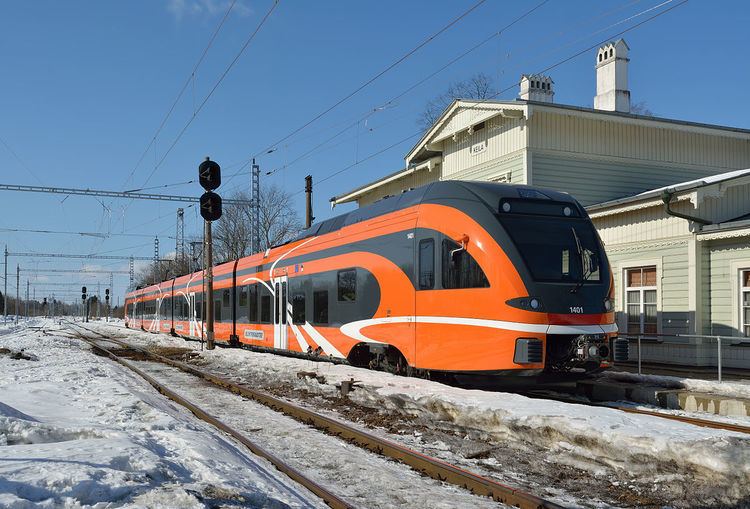 | ||
The rail transport system in Estonia consists of about 1,200 kilometres (750 mi) of railway lines, of which 900 kilometres (560 mi) are currently in public use. The infrastructure of the railway network is mostly owned by the state and is regulated and surveyed by the Estonian Technical Surveillance Authority (Estonian: Tehnilise Järelevalve Amet).
Contents
- Network
- Main lines
- Major industrial railways
- Connections to adjacent countries
- Railway links with adjacent countries
- Operators
- References
All public railways in Estonia are 1,520 mm (4 ft 11 27⁄32 in) (Russian gauge), the same as in Russia, Belarus, Latvia, and Lithuania. The 1,520 mm gauge used in Estonia is also compatible with Finland's 1,524 mm (5 ft) gauge. Sometimes it is defined to be 1,524 mm (see Rail gauge in Estonia), for example when buying track maintenance or vehicles from Finland.
Railways in Estonia today are used mostly for freight transport, but also for passenger traffic. Passenger transport is most frequent near Tallinn, centred on the main Balti jaam.
Network
The Estonian railway network is owned by the state-owned company AS Eesti Raudtee and the private company Edelaraudtee Infrastruktuuri AS. These railway network infrastructure operators provide all railway network services for railway operators running freight and passenger services. AS Eesti Raudtee provides approximately 800 kilometres (500 mi) of track, of which 107 kilometres (66 mi) is double track and 133 kilometres (83 mi) is electrified. Edelaraudtee Infrastruktuuri AS maintains 298 kilometres (185 mi) of track which consists of 219 kilometres (136 mi) of main line and 79 kilometres (49 mi) of station line.
Main lines
Owned by AS Eesti Raudtee:
Passenger trains are operated by Elron (Tallinn–Aegviidu, Tallinn–Tartu, Tallinn–Rakvere and Tallinn–Narva routes) and by GO Rail (international trains to Moscow and St. Petersburg, Russia).
Passenger trains are operated by Elron (Tallinn–Riisipere route).
Passenger trains are operated by Elron (Tallinn–Tartu and Tartu–Jõgeva routes).
Passenger trains between Tartu and Valga are operated by Elron. Passenger trains between Valga and Riga are operated by Latvian Railways.
Passenger trains are operated by Elron (Tartu–Koidula route).
The line is used only by freight trains.
Owned by Edelaraudtee Infrastruktuuri AS:
Major industrial railways
Connections to adjacent countries
Daily passenger service connect Tallinn with Moscow (night train; travel time is 15 hours) through Saint Petersburg, operated by the Russian Railways.
As of summer 2016 three daily trains operated by Latvian Railways connect Riga (Latvia) to Valga (Estonia). The other railway lines to neighbouring countries are not used for direct passenger traffic at the moment. It is possible to travel between Tallinn and Riga with train change at Valga, and the timetables of Tallinn–Valga and Valga–Riga are adjusted for that purpose, but this still takes a long time compared to bus (travel time about 5 hours) or air.
Historic train routes are Tallinn–Moscow via Tartu–Pechory, and Riga–St. Petersburg, which passed through Estonia from Valka, Latvia to Valga, Estonia–Võru–Piusa–Pechory, Russia. Both were closed in the 1990s.
There are plans for a new high-speed line Tallinn–Riga (continuing to Poland), Rail Baltica, planned to be in operation around 2020.
Railway links with adjacent countries
Operators
Freight trains are operated by Eesti Raudtee and private companies including Estonian Railway Services (E.R.S. AS), and Spacecom.
Passenger services are offered by three operators:
